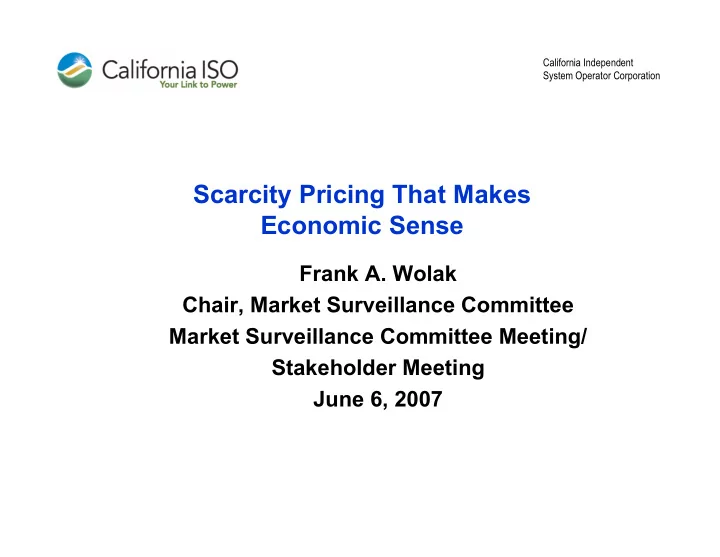

California Independent System Operator Corporation Scarcity Pricing That Makes Economic Sense Frank A. Wolak Chair, Market Surveillance Committee Market Surveillance Committee Meeting/ Stakeholder Meeting June 6, 2007
California Independent System Operator Corporation Outline of Talk How scarcity pricing works in other markets – Examples from airlines, sporting events True scarcity versus artificial scarcity – The trouble with administrative scarcity pricing mechanisms How it should work in electricity markets – Coordinating scarcity pricing mechanism with active participation of final demand in wholesale market – Avoid administrative mechanisms that How it can work under MRTU – Minimum quantity price-responsive demand bids into ancillary services markets 2 June 6, 2007 MSC Meeting
California Independent System Operator Corporation Scarcity Pricing in Other Markets Downward-sloping demand curve allocates a fixed supply – Airlines charge extremely high prices for tickets as flight begins to fill up – Tickets to sold-out events sell for more than list price S(p) P D(p) Q 3 June 6, 2007 MSC Meeting
California Independent System Operator Corporation Distinguishing True from Artificial Scarcity Cost of an administrative procedure based on system conditions to set “scarcity prices” – Suppliers take actions to cause these system conditions to occur – Regulator-sanctioned form of exercising unilateral market power Properly designed scarcity pricing mechanism should limit opportunities for suppliers to exercise unilateral market power in short-term market – Use actual demand-side of market to set scarcity prices not an administrative procedure that can be manipulated by suppliers 4 June 6, 2007 MSC Meeting
California Independent System Operator Corporation How Scarcity Pricing Should Work in Wholesale Electricity Markets There is a substantial amount of price-responsive final demand potential in all wholesale electricity markets – Experimental results with real-time pricing at both residential, commercial and industry levels Approximately 15 percent demand reduction on critical peak days in California – Requires interval or hourly metering to implement any form of real-time pricing – Customers on critical peak pricing (CPP) tariffs are ideally suited to participate in ancillary services and real-time energy market A retailer that has a substantial amount of load on a CPP pricing plan can bid this load as non-spinning reserves – Strike price for energy in real-time market can be set equal to CPP price – Retailer calls CPP event on days that energy bid of load is likely to be accepted 5 June 6, 2007 MSC Meeting
California Independent System Operator Corporation How Scarcity Pricing Should Work in Wholesale Electricity Markets Demand curve used to set “scarcity prices” should be derived from willingness of customers to curtail load in response to higher reserve prices – Retailers offer these demand reductions into non-spinning reserve market Use of administrative demand curve for reserve market can result in reserve and real-time energy market outcomes that impose significant costs on consumers – Very high scarcity prices can be set when many customers would have curtailed demand instead of paying these prices Markets work best when intelligent and financially motivated supply competes against intelligent and financially motivated demand – Market power problems arise when intelligent and financially motivated supply competes against administratively determined demand 6 June 6, 2007 MSC Meeting
California Independent System Operator Corporation How Scarcity Pricing Can Work Under MRTU The ISO can mandate that all load-serving entities must submit non-spinning reserve ancillary services load bids at or below bid cap equal to at least 10 percent of day-ahead energy schedule – Bids on energy must be at or below bid cap on real-time energy market This builds in feasible amount of demand response into both ancillary services and real-time energy market – Eliminates need for administrative mechanism to set scarcity prices – Demand bids will set high energy prices and load will be curtailed in real-time market based on willingness to curtail of loads – Scarcity pricing will function in a very similar manner to how it functions in all other markets Willingness to pay of final consumers determines price at which available supply equals amount demanded at that price 7 June 6, 2007 MSC Meeting
California Independent System Operator Corporation Concluding Comments Scarcity pricing existing in all markets with intelligent demand and supply – No need for administrative scarcity pricing mechanism Develop intelligent and financial motivated demand side of wholesale market – Administratively determined scarcity pricing mechanism very likely to simply reward suppliers for exercising unilateral market power Economically meaningful scarcity pricing that enhances market efficiency results from an active and intelligent demand side of wholesale market 8 June 6, 2007 MSC Meeting
Recommend
More recommend